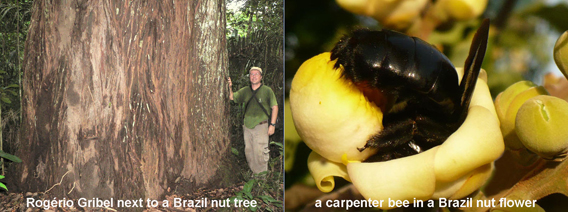Brazil Nuts: From the Flower to Your Party Mix
Posted in Interesting Plant Stories on January 10, 2014 by Scott Mori
Rogério Gribel, Ph.D., is the Director of Scientific Research at the Rio de Janeiro Botanical Garden in Brazil, and Scott A. Mori, Ph.D., is the Nathaniel Lord Britton Curator of Botany at The New York Botanical Garden. They have studied all aspects of Brazil nut classification, ecology, evolution, and conservation for most of their careers.

Here’s a video that shows how essential big, strong bees are for the production of the largest “nut” found in a can of mixed party nuts. It shows a carpenter bee (Xylocopa frontalis) pollinating the flowers of a Brazil nut tree (Bertholletia excelsa).
We say “nut” because Brazil nuts are seeds, not nuts, a kind of fruit structurally similar to an acorn. The Brazil nuts we eat at parties are produced in a woody fruit that looks like a cannonball, so, to be botanically correct, Brazil nuts should be called Brazil seeds. But we don’t expect that to happen anytime soon!
The flowers of this Amazonian tree are relatively large, usually reaching three to four centimeters—or nearly two inches—in diameter. The petals and male part of the flower are cream-colored with a conspicuous patch of yellow at the entrance into the flower. The male part of the flower has an elongated extension, called the ligule, stretching from one side of a ring of fertile stamens and curving over the top of the ovary. No other plant apart from the Brazil nut family possesses a similar structure.
The ligule has several important functions. One is to keep non-pollinators from robbing nectar and pollen, and the other is to produce nectar that serves as a reward for legitimate pollinators. In addition to the ligule’s blocking entry into the flowers, the petals press tightly against it, making entry into the flowers even more difficult for nectar thieves.
As the video shows, a determined bee, guided by the yellow spot at the entrance to the flower, forces its way into the flowers, extracts nectar from the ligule, and gets dusted with pollen on its head and back while inside the flowers (the yellow material covering the bee in the video is pollen). At the next flower, the bee brushes past a part of the female reproductive system called the stigma, leaving some of the pollen on it. That begins the process that leads to Brazil “nuts.” Although bees visit other flowers in the same tree, the pollen that bees move from one tree to another results in most of the seeds produced by Brazil nut trees.
The video was produced by Rogério Gribel and Aldenora L. Queiróz in the vicinity of Manaus, Amazonas, Brazil. They are grateful to the Instituto Nacional de Pesquisas da Amazônia and the Instituto de Pesquisas do Jardim Botanico do Rio de Janeiro for supporting their research on Brazil nut pollination.

